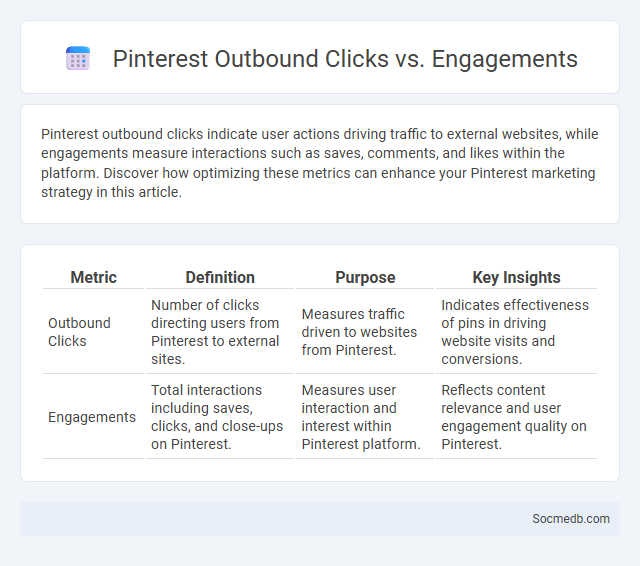
Photo illustration: Pinterest Outbound Clicks vs Engagements
Pinterest outbound clicks indicate user actions driving traffic to external websites, while engagements measure interactions such as saves, comments, and likes within the platform. Discover how optimizing these metrics can enhance your Pinterest marketing strategy in this article.
Table of Comparison
| Metric | Definition | Purpose | Key Insights |
|---|---|---|---|
| Outbound Clicks | Number of clicks directing users from Pinterest to external sites. | Measures traffic driven to websites from Pinterest. | Indicates effectiveness of pins in driving website visits and conversions. |
| Engagements | Total interactions including saves, clicks, and close-ups on Pinterest. | Measures user interaction and interest within Pinterest platform. | Reflects content relevance and user engagement quality on Pinterest. |
Understanding Pinterest Outbound Clicks
Pinterest outbound clicks measure the number of times users click on pins to visit external websites, reflecting direct traffic driven by the platform. Tracking these clicks provides valuable insights into user engagement and the effectiveness of Pinterest as a referral source, crucial for digital marketing strategies. Analyzing outbound clicks helps businesses optimize content and targeting to boost website visits and conversion rates from Pinterest traffic.
What Are Pinterest Engagements?
Pinterest engagements refer to the interactions users have with your pins, including saves, clicks, comments, and close-ups that indicate interest in your content. These engagements help increase your content's visibility on the platform by signaling relevance and quality to Pinterest's algorithm. To boost your Pinterest engagements, you can optimize your pins with keywords, create visually appealing graphics, and encourage user interaction through clear calls to action.
Outbound Clicks vs Engagements: Key Differences
Outbound clicks measure how often users leave your social media page to visit external websites, providing direct insight into traffic driven by your content. Engagements include a broader range of interactions such as likes, comments, shares, and clicks within the platform, reflecting overall audience involvement with your posts. Understanding the distinction helps you optimize Your social media strategy by balancing content that drives traffic with posts that foster user interaction and brand loyalty.
Why Track Outbound Clicks on Pinterest?
Tracking outbound clicks on Pinterest provides critical insights into user engagement by revealing which pins drive traffic to external websites. This data helps marketers optimize their content strategies, improve targeting, and measure the effectiveness of their campaigns in generating leads or sales. Understanding outbound click behavior enables businesses to maximize return on investment (ROI) from Pinterest advertising and organic efforts.
How Pinterest Measures Engagements
Pinterest measures engagements through key metrics such as pin saves, clicks, close-ups, and comments, providing insight into user interaction with content. The platform tracks how often users save pins to their boards, click through to external links, and expand images to gain detailed views. These engagement signals help Pinterest optimize content recommendations and improve user experience by highlighting popular and relevant pins.
Interpreting Outbound Clicks Versus Engagement Data
Understanding the distinction between outbound clicks and engagement data is crucial for optimizing your social media strategy. Outbound clicks measure the number of users who leave the platform to visit external links, directly indicating interest in your content or offers. Engagement data, including likes, shares, and comments, reflects interaction and brand affinity but does not always translate into tangible actions like website visits or conversions.
Impact of Outbound Clicks on Website Traffic
Outbound clicks significantly boost website traffic by directing users from social media platforms to targeted web pages, increasing visibility and engagement rates. High-quality outbound links from popular social media channels like Facebook, Twitter, and Instagram enhance referral traffic and improve search engine rankings through increased user activity signals. Tracking outbound clicks provides valuable insights into user behavior and content performance, enabling marketers to refine strategies for optimal audience conversion and retention.
Optimizing Pins for Engagement and Outbound Clicks
Optimizing pins for engagement and outbound clicks involves using high-quality, visually appealing images paired with clear, keyword-rich descriptions that target relevant audiences on platforms like Pinterest. Incorporating strong call-to-actions (CTAs) within pin descriptions and utilizing rich pins with product or article metadata can significantly increase click-through rates. Regularly analyzing pin performance metrics and adjusting designs or keywords based on user interaction trends boosts both engagement and outbound traffic effectively.
Common Mistakes in Analyzing Pinterest Metrics
Common mistakes in analyzing Pinterest metrics include misinterpreting engagement rates by focusing solely on likes without considering saves and clicks, which more accurately reflect user interest and content value. Overlooking the impact of seasonal trends and pin lifespan can lead to incorrect conclusions about performance fluctuations. Ignoring audience demographics and behaviors results in strategies that fail to target the right user segments effectively.
Best Practices for Improving Outbound Clicks and Engagements
Optimizing your social media strategy includes crafting compelling calls-to-action (CTAs) that clearly guide your audience toward clicking outbound links and increasing engagement. Use visually appealing content and concise, targeted messaging to capture attention and enhance click-through rates, ensuring your posts are mobile-friendly for seamless user experience. Consistently analyze performance metrics such as click-through rate (CTR), engagement rate, and time spent on linked pages to refine your approach and maximize the effectiveness of your outbound marketing efforts.
 socmedb.com
socmedb.com